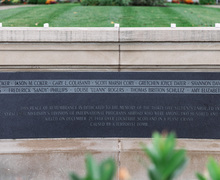What is JMA Wireless, the company reportedly taking over the naming rights of the Dome?
Meghan Hendricks | Photo Editor
Carrier has had naming rights over the Dome since its opening in 1980. JMA Wireless has taken over.
Get the latest Syracuse news delivered right to your inbox. Subscribe to our sports newsletter here.
Syracuse’s Carrier Dome will receive its first-ever name change after 43 years on May 1, with local company JMA Wireless expected to become the venue’s new naming rights holder.
“With Carrier’s cooperation, we will seek to rename our stadium while we continue our work to transform the experience for our students, faculty, staff, fans and central New York community,” Syracuse Director of Athletics John Wildhack said in an SU Athletics release.
JMA Wireless, based in Syracuse, specializes in delivering more secure networks for consumers and businesses to accelerate mobile connectivity, per the company’s website. According to an article by Sportico, the change would likely require at least $3.25 million annually on the open market, citing an outside marketing group’s report. Carrier paid $2.75 million for perpetual naming rights when the Dome was being constructed in 1979.
JMA Wireless hasn’t yet responded to a request for comment.
The process of renaming the stadium is a part of SU’s plan to “enhance the stadium experience,” building on the recently completed $118 million transformation of the venue. The university plans to add a complete reseating of the venue and a publicly-accessible event facility.
Construction on the stadium will begin later this spring, and should be partially complete as early as this September. Syracuse men’s lacrosse head coach Gary Gait said that the name change is “fine,” but that the upgrades and the modernization of the facility will be key for all Syracuse athletic teams.
“It’s still the same facility, just a name,” Gait said. “The remodel is very important to our athletic program.”
Syracuse first hinted at a potential name change in 2019 when it stopped referring to the stadium as the Carrier Dome, instead referring to it as the “Dome,” “Stadium” or “Loudhouse” in the preseason football media guide. Wildhack said in 2019 there was “no rhyme or reason” for a change, and the department didn’t reach out to Carrier about a change.
“I’ve been coming to games forever, I’ve always referred to it as the Dome,” Wildhack said. “The name Carrier is on the outside of the building. There’s no intent.”
JMA Wireless was founded in 2012 by John Mezzalingua, who was previously the CEO of PPC, a manufacturer of technology products to the cable TV industry. JMA created the first fully virtualized RAN for carrier and private networks as well as the U.S.’ first indoor 5G millimeter wave radio, according to its website.
In 2019, the company announced its biggest project, which involved housing the indoor 5G millimeter wave radio at a downtown Syracuse building. The campus, which would “span a city block and support a multitude of consumer- and business-facing demos” replaced the prior Coyne Textiles facility. According to JMA’s release, the investment cost $25 million dollars and would open at least 100 new jobs in manufacturing, testing and production support.
“We’re continuing investment in New York to set the pace for U.S.-driven 5G innovation, something we’ve been told too often must come from international providers,” Mezzalingua said in the release.
The expansion of JMA Wireless and Bankers Healthcare Group — a medical financing and loan company based in Syracuse — at the time were part of a larger revitalization effort in Syracuse and central New York, Mayor Ben Walsh told The Daily Orange in 2020. The JMA Wireless expansion aligns with the Syracuse Surge initiative, an initiative aimed to improve the city’s economy through technological advancements, Walsh said.
“To have a company like JMA invest in a facility on the Southside of Syracuse, where our strategy is focused, we couldn’t have written a better script,” Walsh said.

Megan Thompson | Design Editor
JMA Wireless has its global headquarters located in Liverpool, New York, with technology centers domestically in Chicago, Boulder, Dallas, Austin and Richmond. Abroad, the company also has centers in Dublin, Ireland, and Bologna, Italy.
One of the company’s latest projects has been with the Milwaukee Bucks’ arena, Fiserv Forum, which opened in 2018. JMA Wireless helped provide the “best mobile communications” with a distributed antenna system for the stadium.
The changes in the Dome will also include an upgraded digital infrastructure, SU Athletics announced. Ken Garno, who was the project manager for the Dome’s electrical work when it was first built, said to The D.O. that the main reason behind the name change was “just about money.”
“At that time, they needed to raise $25 million, Carrier gave them $3 million for the name and they were happy to sell,” Garno said.
But Garno joked that a potential JMA Wireless Dome is “a lot of words,” and even though SU has been trying to get out of the deal with Carrier for years, the change won’t be significant at a local level.
“People are still going to call it the Dome, local people are still going to call it the Carrier Dome,” Garno said.
Staff writer Adam McCaffery contributed reporting.
Published on April 20, 2022 at 10:06 pm
Contact Anish: asvasude@syr.edu | @anish_vasu





